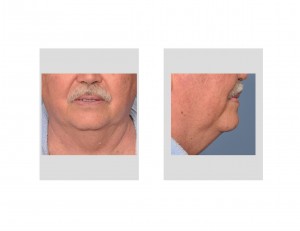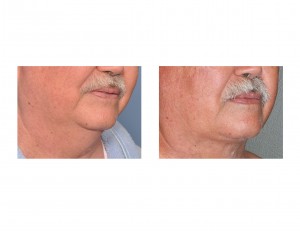Background: One of the most bothersome facial features in late middle-aged and older men is the droopy neck or neck wattle. The skin of the jowls and neck eventually develops some sag due to its weight and loss of underlying attachments. This will be magnified in those men who have fat collections that have developed in the neck and often have a bit of a body weight issue.
The sagging neck in older men always has a significant component of extra skin that has lost some amount of its original elasticity. This means that the best treatment is a procedure that addresses both loose skin and too much fat. The well known name for that procedure is a lower facelift or necklift. It is tremendously effective because it both removes the extra neck skin and lifts it as well. However, many men would prefer to avoid a facelift for a variety of understandable reasons including cost and recovery issues.
Short of a facelift, the only other neck treatment option is liposuction. If significant neck fat is present, liposuction will offer some improvement. The key question is how much? And does the result justify the effort? While no result can be predicted with absolute certainty, one predictor is the quality of the neck skin. Is it thick or thin? Does the neck feel tight or does it feel loose? Does it feel like there is a significant fat layer between the skin and the muscle. These are all signs that liposuction may offer a promising improvement in the profile of one’s neck.



It is hard to know precisely what role laser liposuction had in getting such a good result. In my opinion, it clearly provides some benefit just hard to know whether it is significant compared to traditional liposuction alone. Heating the subcutaneous tissues of the neck prior to fat extraction seems like a beneficial step to do and may help in decreasing bruising and improving the quality of the skin retraction. While this result should not be confused with what a necklift can do, it was more than satisfactory for his expectations.
Case Highlights:
1) The traditional approach for fixing a neck wattle in an older male is a necklift. (facelift) In some cases, liposuction may make enough of an improvement to avoid any type of skin removal or lifting.
2) The success of liposuction in improving the sagging neck in an older male depends on the elastic quality of the neck skin and the expectations of the patient.
3) Smartlipo (laser liposuction) offers an edge in neck liposuction by potentially improving the retraction of the overlying neck skin, which is essential to avoid skin that is loose and rippled.
Dr. Barry Eppley
Indianapolis, Indiana


